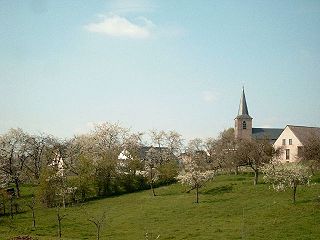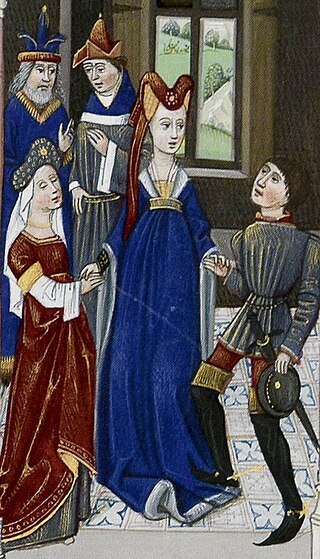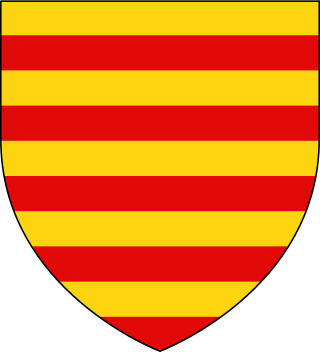
The County of Loon was a county in the Holy Roman Empire, which corresponded approximately with the modern Belgian province of Limburg. It was named after the original seat of its count, Loon, which is today called Borgloon. During the middle ages the counts moved their court to a more central position in Kuringen, which today forms part of Hasselt, capital of the province.

The Hesbaye, or Haspengouw, is a traditional cultural and geophysical region in eastern Belgium. It is a loamy plateau region which forms a watershed between the Meuse and Scheldt drainage basins. It has been one of the main agricultural regions in what is now Belgium since before Roman times, and specifically named in records since the Middle Ages, when it was an important Frankish pagus or gau, called Hasbania in medieval Latin.

Louis II was count of Loon from 1191 to 1218. He was the son of Gerard, Count of Looz, and Adelaide of Gelderland, daughter of Henry I, Count of Guelders, and Agnes of Arnstein, daughter of Louis III of Arnstein. He also claimed to be the legitimate Count of Holland during the Loon War (1203–1206).

The Château de Duras in Duras, a half hour walk to the north of Sint-Truiden in Belgium, is built in the Classical style.
Giselbert van Loon is the first definitely known count of the County of Loon, a territory which, at least in later times, roughly corresponded to the modern Belgian province of Limburg, and generations later became a lordship directly under the Prince-bishopric of Liège. Very little is known about him except that he had two brothers, one of whom, Bishop Balderic II of Liège, is much better attested in historical records.

Arnold IV of Loon (Looz) (died between November 1272 and October 1273; most likely on February 22, 1273), was Count of Loon from 1227 to 1273 and Count of Chiny (as Arnold II) from 1228 to 1268. He was the son of Gérard III, Count of Rieneck and Cunegonde von Zimmern.

Louis I was the Count of Loon, now in modern Belgium, and Burgrave of Mainz, in Germany. He inherited these offices from his father. He also established the County of Rieneck apparently based upon the Burgrave's lands.

Arnold V de Looz, was Count of Loon from 1279 to 1323 and Count of Chiny from 1299 to 1310. He was the son of John I, Count of Looz and Mathilde Jülich.
Count Emmo, Immo or Emmon is one of the first known counts of Loon in the region of modern Belgian Limburg. Before him one more count is known with confidence, Count Giselbert, but it is not certain that Giselbert was Emmo's father. Verhelst for example has proposed that he was his uncle, and that Giselbert's brother Count Arnulf was father of Emmo and also a count of Loon.
Arnold I, Count of Loon (Looz) from about 1079, son of Emmo, Count of Loon, and Suanhildis, daughter of Dirk III, Count of Holland, and his wife Othelandis.

Arnold II, Count of Loon, son of Arnold I, Count of Loon, and Agnes von Mainz, daughter of Gerhard I, Count of Rieneck, and Helwig von Bliescastel. He is distinguished from his father of the same name by historians who note records for counts named Arnold or Arnulf between 1179 and 1141. The first Arnold must have died between 1125 when Count Arnold appears in a record with his son also named Arnold, and 1135, when a new Count Arnold appears with his own son and successor Louis.
Henry, Count of Looz and Count of Duras, son of Gérard II, Count of Looz, and Adelaide of Gelderland, daughter of Henry I, Count of Guelders, and Agnes of Arnstein, daughter of Louis III of Arnstein.
Arnold III, Count of Looz and Count of Rieneck, son of Gérard II, Count of Looz, and Adelaide of Gelderland, daughter of Henry I, Count of Guelders, and Agnes of Arnstein, daughter of Louis III of Arnstein.
Gerard, Count of Rieneck, son of Gerard, Count of Loon, and Adelaide of Gelderland, daughter of Henry I, Count of Guelders, and Agnes of Arnstein, daughter of Louis III of Arnstein.
Louis III, Count of Looz, also known as Ludwig was Count of Loon and of Rieneck. He was the son of Gerard, Count of Rieneck, and Cunegonde von Zimmern, who was in turn the son of another Count Gerard who was also count of both Rieneck and Loon.
The pagus or gau of Hasbania was a large early medieval territory in what is now eastern Belgium. It is now approximated by the modern French- and Dutch-speaking region called Hesbaye in French, or Haspengouw in Dutch — both being terms derived from the medieval one. Unlike many smaller pagi of the period, Hasbania apparently never corresponded to a single county. It already contained several in the 9th century. It is therefore described as a "Großgau", like the Pagus of Brabant, by modern German historians such as Ulrich Nonn.
Count Rudolf, was a count in Lower Lotharingia, who apparently held possessions in the Hesbaye region and in the area of Meuse river north of Maastricht. It has been proposed that he was a son of Reginar II, Count of Hainaut, and thus a member of the so-called Regnarid dynasty.
The County of Duras was a medieval county with its seat at the castle of Duras. The 18th century version of this castle still stands and is a part of modern Sint-Truiden in the province of Belgian Limburg. The county was one of several counties in the Hesbaye region which covers parts of several Flemish and Wallonian Provinces of Belgium. As a distinct entity under the name Duras the county only existed within the 12th century. After the first male line of counts died out, the county of Duras came by marriage to the Counts of Montaigu, whose other holdings were further south. Duras itself became part of the neighbouring County of Loon, which was at that time ruled by cousins of the original counts of Duras.
Count Otto of Loon as he was known during his own lifetime, was founder of the family of Counts of Duras, and brother of Emmo, Count of Loon, one of the first known counts of Loon. In contemporary and later medieval records he is mainly known for his role as advocate of Sint-Truiden Abbey, which is today in Belgian Limburg.
Count Otto of Duras was a count of Duras, and advocatus of the nearby abbey of St Truiden. Duras and St Truiden are in the modern province of Belgian Limburg. His parents were Count Giselbert of Duras and his wife Gertrud.